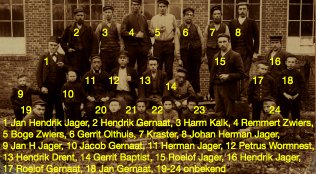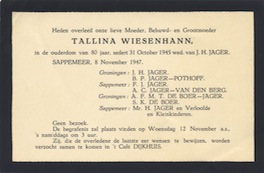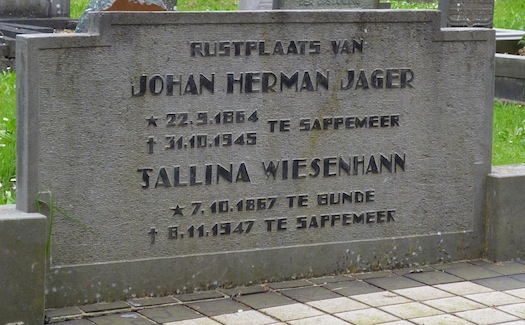Johan H Jager grew up with the woodworks factory of his father, Jan Hendrik Jager, in Sappemeer. He sang in a local choir and so went regelarly to befriended choirs in the vicinity, like the choir of Bunde (just across the border with Germany). In that choir sang Tallina Wiesenhan.
Tallina was the daughter of an esteemed farmer in Holthusen near Bunde (Ost Friesland, D). She had received a good education and sang in a choir.
Johan and Tallina married in 1893 and then lived in Sappemeer.
By the end of the 1890s the sons

|
Now advertisements of the company appeared (father Jan had not done ads). There was ample work and one always needed fresh wood (see advertisment in Nieuwsblad van het Noorden 18981204). For more notes see the newspaper clips.

|
In about 1897 a photo was made of family and staff (with children)
of the factory. On the photo are several Jagers:
father Jan Hendrik (1, director) and his brother Johan Herman (11);
then the sons of 1 succeeding him: Johan Herman (8),
Hendrik (16) and Roelof (15); and the grandson Jan H (9).
See also the photo without text.
(The identification op people has in part been taken from
Smedes, "Rond Veenborg en Hooghout - Kleine historie van
Hoogezand en Sappemeer", 1984, De Libreije, Hoogezand.)
About some of the other people in the photo one can find more at
Wormnest.
Photos: House and terrain at "Zuiderstraat 145" on the
Winschoterdiep.
For the lay-out of the terrain see the map in the
clippings.
The canal under the bridge runs along the factory land.
In the hey days, the bridge was a "hoog-holtje"
(a high foot bridge).
One can see the shed for wood and planks and in the back (behind the hoist)
part of the factory building.
The aireal photo shows the rails from the Winschoterdiep
to the shed and the factory building.
[The photos are from ~1950, Johan and Tallina had already died.]
Father Johan died in 1900, a year later mother Grietje.
Johan Herman and his wife Tallina came to live in the house at the factory.
Johan, in fact, became the leader of the company.
Tallina decorated her house in the style of her parents
and with german style window dressings (so she became the
"different one" in the neighboorhood).
 
|
Soon after the death of father Johan and mother Grietje a family photo was made. Portraits of his parents hung in the background. The faces of Johan and Tallina were taken from this family photo.

|
In 1913, the factory was destroyed by fire. Fortunately, all was well insured. The rebuild must have looked somewhat different from what had been before.
During all his life, Johan had a large moustache. In order that the moustache would not soak in tea or coffee, Tallina had bought a "moustache-cup". Its extra piece of porcelain kept the hairs out.
Children: 1894 Jan (nr 9 on the photo above, later architect),
1898 Frits (succeeded in the company), 1903 Hendrik/Henny (later lawyer),
1908 Anna Frieda Magaretha Tallina.
In 1921, Johan registered his factory at the Chamber of Commerce as
J.H. Jager & Sons, Brushhandle and Carpentry Factory.
In the 1920s, the company encountered hard times
while also artificial material became available (e.g. bakelite).
Johan was often on the road to find clients.
Daughter Frieda remembers:
"When coming home again, Ma looked enquiring and could
mostly read the results of his days toils from his face."
But faltering could not be avoided
(see newspaper clip).
The company and the three brothers were declared broke in 1927.
The children of Johan and Tallina, in so far still at home,
had to go out and earn money.

|
But in that same year, 1927, Johan registered a new company with the Chamber of Commerce, again "J.H. Jager & Sons", but the activities are extended to also include contract work and trading in wood.
Later, the factory was taken over by son Frits, who ran the business until 1966.
During the world war, things were difficult too, but the family managed.
In 1942 a photo was taken with the first child of daughter Frieda.
Right after the war, more photos were taken of Johan and Tallina.
Comparing these with the ones from about 1900 show how the couple has aged
(see JJandTW).
Johan died in 1945 and son Frits took over the factory. Tallina retreated into a small unit behind the house (see A on map).
Johan and Tallina have been burried in the graveyard of the Cupola Church in Sappemeer (in row with nummer 43-56). Also Johan's parents and some other family mebers have their grave there.
The factory was continued for many years by son Frits. Around 1980, the house and the factory buildings have been taken down to become, with further land, part of a new residential area.
In a conversation with son Klaas in 1980,
Frieda characterised the members of the family as follows.
Son Jan rather resembles the Wiesenhans, very just and fair.
Son Frits resembles his father Johan;
after Frits had died his face was clearly similar to that of
the mother of grandfather Jan Jager, thus Maria Adelheid Klöne.
Son Henny is like the Jager family, mostly the Gernaat side.
Frieda herself looked like her mother Tallina,
but even more like her grandma Antje Mulder.
To the ancestry with JHJ & TW. To dutch version.



